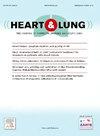用LF-NMR间接评价囊性纤维化患者胸部物理治疗或ETI治疗后的肺部状况。
IF 2.6
4区 医学
Q2 CARDIAC & CARDIOVASCULAR SYSTEMS
引用次数: 0
摘要
背景:随着大多数囊性纤维化(CF)患者进展为呼吸衰竭,肺功能评估是关键。我们之前开发了一种测试,使用低场核磁共振(LF-NMR)监测气道测量痰中存在的水氢的自旋-自旋弛豫时间(T2m)。目的:进一步探讨T2m探测的意义:1)T2m与胸部物理治疗(CP)效果的相关性;2)唾液污染痰液对T2m的影响;3) T2m与痰片粒径的关系;4) T2m与cftr调制器elea -caftor/Tezacaftor/Ivacaftor (ETI)效应的相关性。方法:测定16例cf患者CP治疗前后和9/16例患者ETI治疗前后痰中T2m含量。采用标准技术测定FEV1/C反应蛋白(CRP)/红细胞沉降率(ESR)和汗液氯化物浓度。用数学方法测定唾液污染/痰网大小。结果:我们证明T2m可以检测CP对肺功能无明显影响(FEV1证实)。此外,我们开发了一种数学方法来校正被唾液污染的痰样本中的T2m值,并确定T2m与痰网尺寸之间的关系。最后,我们发现T2m可以有效检测ETI对肺功能的积极影响(通过FEV1评估),并且T2m与CRP/ESR/氯化物汗液浓度呈负相关。结论:该数据加强了在CF肺病监测中使用T2m的理论基础,并表明T2m可以有效地补充FEV1检测。本文章由计算机程序翻译,如有差异,请以英文原文为准。
Indirect evaluation of lung condition by means of LF-NMR following chest physiotherapy or ETI administration in cystic-fibrosis patients
Background
As most cystic fibrosis (CF) patients progress to respiratory failure, lung functionality assessment is pivotal. We previously developed a test that monitors airways measuring the spin-spin relaxation time (T2m) of water hydrogens present in sputum using Low Field-Nuclear Magnetic resonance (LF-NMR).
Objectives
To investigate further the significance of T2m exploring: 1) T2m correlation with the effects of chest physiotherapy (CP); 2) the influence of sputum contamination by saliva on T2m; 3) T2m relation with sputum mesh size; 4) T2m correlation with the effects of the CFTR-modulator Elexa-caftor/Tezacaftor/Ivacaftor (ETI).
Methods
T2m was measured in the sputum of 16 CF-patients before/after CP and in 9/16 patients before/after ETI administration. FEV1/C reactive protein (CRP)/erythrocyte-sedimentation rate (ESR) and sweat chloride concentration were measured using standard techniques. Sputum contamination by saliva/sputum mesh size were determined mathematically.
Results
We prove that T2m can be used to detect the lack of significant effects on lung function by CP (confirmed by FEV1). Moreover, we developed of a mathematical approach to correct T2m value in sputum samples contaminated by saliva and to determine the relationship between T2m and sputum mesh size. Finally, we show that T2m can effectively detect the positive effects of ETI on lung function (evaluated by FEV1) and that T2m inversely correlates with the CRP/ESR/chloride sweat concentration.
Conclusion
This data strengthens the rationale for T2m employment in CF lung disease monitoring and show that T2m can be profitably used to complement the FEV1 test.
求助全文
通过发布文献求助,成功后即可免费获取论文全文。
去求助
来源期刊

Heart & Lung
医学-呼吸系统
CiteScore
4.60
自引率
3.60%
发文量
184
审稿时长
35 days
期刊介绍:
Heart & Lung: The Journal of Cardiopulmonary and Acute Care, the official publication of The American Association of Heart Failure Nurses, presents original, peer-reviewed articles on techniques, advances, investigations, and observations related to the care of patients with acute and critical illness and patients with chronic cardiac or pulmonary disorders.
The Journal''s acute care articles focus on the care of hospitalized patients, including those in the critical and acute care settings. Because most patients who are hospitalized in acute and critical care settings have chronic conditions, we are also interested in the chronically critically ill, the care of patients with chronic cardiopulmonary disorders, their rehabilitation, and disease prevention. The Journal''s heart failure articles focus on all aspects of the care of patients with this condition. Manuscripts that are relevant to populations across the human lifespan are welcome.
 求助内容:
求助内容: 应助结果提醒方式:
应助结果提醒方式:


